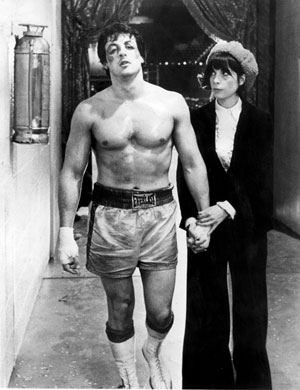 The Stuff of Legend
The Stuff of Legend
In this age of stock plots and by-the-numbers stories, I thought it would be nice to look back at Rocky [Amazon | IMDB] — a little spec script that broke the rules in 1976, became a box office sensation and won the Oscar for Best Picture.
The story behind the script itself is the stuff of Hollywood legend. An unknown screenwriter (and virtually unknown actor), Sylvester Stallone, writes a spec script so amazing that he is able to insist on starring in the movie’s title role.
The script itself, in addition to being nominated for Best Screenplay honors in 1977, is later hailed by the Writers Guild of America, West, as one of the 101 greatest screenplays of all time.
Thar Be Spoilers
If you’re young enough that you’ve never seen, or heard of (cringe), Rocky, then I suggest you stop reading now and simply go rent or buy the movie. While its sequels eventually became formulaic and over-the-top, the original Rocky is a masterpiece of low-budget filmmaking, that tugs at your heart-strings and gives you a unique character you can’t resist rooting for.
A Late Catalyst
What’s really amazing is that the movie does not follow conventional wisdom about screenplay structure. Most movies these days adhere to the rule that the Catalyst or Call to Adventure1 must happen within the first 10 to 15 minutes.
Incredibly, in Rocky, the Catalyst/Call to Adventure doesn’t arrive until the 53 minute mark! That’s when Rocky gets notified that Apollo Creed’s promoter is looking to talk with him.
How is it possible that the catalyst doesn’t arrive until the 53 minute mark? What happens for that extra 40 minutes or so to keep the audience engaged?
 Why We Don’t Mind a Long Set Up
Why We Don’t Mind a Long Set Up
Rocky’s dreams of being a heavyweight champion are like my dreams of dating a supermodel who’s made of dark chocolate — it’s something too fantastical to even consider. What Rocky really dreams of is being respected. He also wants Adrian — the shy but cute pet store worker — to like him.
The first half of the movie spends its time on five things:
- Showing Rocky’s challenging life
A partial list: He gets called a “bum” at a boxing match, his gym locker taken away, the cold shoulder from Adrian and grief from her co-worker, yelled at by boxing coach Mickey, heckled by his boss’s driver, told to screw off by a little girl… All things to earn Rocky sympathy with the audience. - Showing us that Rocky’s a great guy
There are so many Save the Cat2 moments. A partial list: Rocky says hi to a puppy in a pet store window, he looks after his turtles, let’s a guy off the hook for not having enough money to pay back his loan shark boss, brings a drunk inside who’s passed out on the street, tries to help a young girl avoid a bad rep, spends 10 bucks to take Adrian ice skating after hours… - Developing Rocky’s Character
This is a big one. Without this one, the above two points don’t mean anything. All of the above mentioned items are done in ways that develop one of the most original and engaging characters to ever appear in film. He’s the bruiser with a heart of gold and the dialogue is absolutely priceless. There’s never a dull moment because you can’t wait to hear what’s going to come out of his mouth next. 15 minutes in, you don’t need a catalyst because you simply love watching this guy’s life. - The romance with Adrian
Of course even the most compelling characters need a goal; something the audience can track. For the first half of the film, Rocky’s goal is to get Adrian. Everything else in Rocky’s life is so crappy that you hope against hope that he’ll at least find some happiness with Adrian. They have their first kiss at minute 52 — just before the catalyst scene. - Setting Up the Eventual Heavyweight Fight
The prospect of a prize fight is only sprinkled in for flavor a couple of times in the first half of the movie (the first time is at minute 30). Rocky doesn’t know his fate is going to change, but the audience does. That creates dramatic tension. An anticipation and excitement in the audience that something big is going to happen in Rocky’s life.
The All Is Lost Moment
In almost all movies the hero reaches a point of extreme crisis where they believe that all is lost. Usually that happens late in the second act. The hero then summons his/her courage and decides to push forward into the third act.
In Rocky, the “All is Lost” moment comes at the beginning of the third act. After one of the best training montages of all time (which carries us into the third act), at minute 93, Rocky goes to the arena where the fight is going to take place. The poster they’ve created for Rocky has the wrong color shorts. The boxing promoter tells Rocky that it doesn’t really matter. He knows Rocky’s going to give them a great show.
And that’s when it hits Rocky — at minute 96 — he can’t beat Apollo Creed. It then leads into the poignant scene with Adrian where he summarizes his real dream:
“All I want to do is go the distance. If that bell rings and I’m still standing, I’m gonna know for the first time in my life you see, that I’m not just another bum from the neighborhood.”
It’s worth noting that the early third act “All Is Lost”/”Dark Night of the Soul”3 sequence is not super uncommon. I’ll provide some more examples of such movies in a future post.
Summary
There are many other wonderful and unique touches in this film:
- Gazzo, the gangster boss who’s a really nice guy
- Paulie, the alcoholic loose-cannon brother of Adrian
- Mickey, the crotchety old boxing coach who gets one last chance at glory
- Apollo Creed’s concerned trainer (“He doesn’t know it’s a damn show. He thinks it’s a damn fight!”)
- The fact that Rocky loses the fight at the end of the movie
- Bill Conti’s powerful music
The bottom line though is that it’s okay to break the rules (of structure or anything else for that matter) as long as you know the reasons behind the rules in the first place, and can keep the reader/audience engaged in your story.
- the Catalyst/Call to Adventure is the opportunity or incident that shakes up the hero’s regular world ↩
- Save the Cat moments are those scenes where a hero does something like saving a cat to make the audience like him or her. The expression was coined by Blake Snyder. ↩
- “All Is Lost”/”Dark Night of the Soul” — More Blake Snyderisms ↩






I really enjoyed reading this article. I love the first two Rocky films, and I’m familiar with Blake Snyder’s Save the Cat book and it’s sequels. The brief study of the film in relation to STC was informative, and a pleasure to read.
Hey Joseph,
I really appreciate your taking the time to leave me a note. With all of the sequels, many people forget how incredibly good the first couple of films were. Glad you enjoyed the article.
Cheers,
Trevor
Trevor,
For me it’s always been the first two, that’s where it should have ended, perfect ending too, really emotional. You have to be a rock not to be moved by the music and the performance.
I’ve read several of your articles already and decided to copy and paste them in order to keep for future reference. I’ll refer to them before I’m ready to jump in at the deep end. There’s a lot of useful information, and you convey it really well.
Joseph
Oh yes, that Rocky music — talk about a score elevating a movie!
Thanks Joseph, much appreciated.
Great article
Best analysis of the unusual plot structure of Rocky I have ever come across. Well done Trevor Mayes!. It truly is a masterpiece of script writing and casting.. The story benefitted enormously by not having a Hollywood ”pretty boy” playing the lead. It made the audience more sympathetic toward Rocky. Adrian is not a raving beauty but she is very appealing as a cute but mousey love interest. Talia Shire played her perfectly. The supporting cast was superb.. especialy Burgess Meredith as Mickey. (At the time , he was a risky cast as he was best known to US audiences as Penguin on the Batman TV series.. I thought it was very dangerous to cast him because of that but he proved me wrong… Great scenes every one contrasting between being a hard-nosed trainer and a very vulnerable old man with only one shot left. The humor in Stallone’s script is simply brilliant in helping to define the main character.. the vignettes showing what a kind soul he was; equally brilliant. A hard film to shoot with all those night shots on the street. A true masterpiece of filmmaking in virtually every way… Lots of respect is due Sylvestor Stallone…
Hey Doc! I really appreciate the compliment. And I agree with everything you said. They had so many behind the scenes challenges — it makes the resulting film all the more amazing. I didn’t know about that casting controversy. Hard to imagine anyone else as Mickey. The gamble definitely paid off. Thanks for sharing!
Reading this for a class but would have read it for pleasure. This is great analysis. I saw Rocky in the theaters when I was a kid and was moved even then. I’ve always thought it was a shame that Sylvester Stallone became more associated with the Rocky and Rambo sequels than the original Rocky and First Blood which were both just terrific.
Hi Carmen, thanks for your feedback! I agree with your assessment of Sly’s career. People remember the schlock and the blood and guts of his later roles, but his amazing performance in ROCKY is often forgotten. And yeah — FIRST BLOOD is one of my favorite movies of all time. One of two films where I had literally every line memorized!